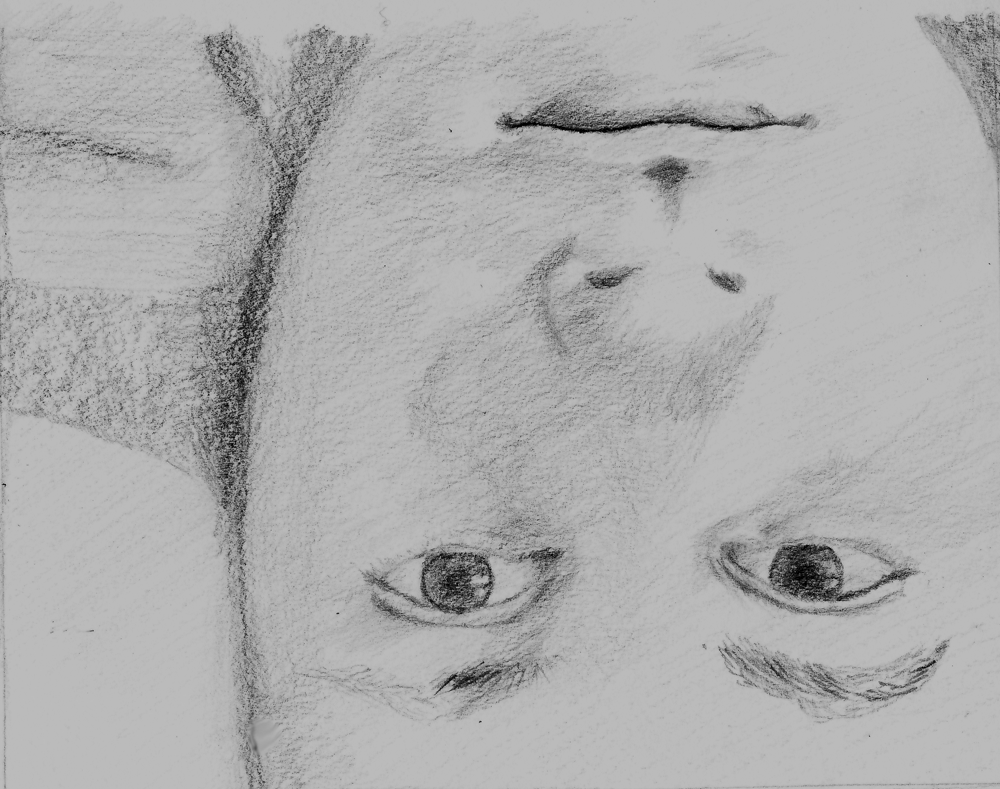A Self-Portrait in Oils
|
As someone hoping to have portraits commissioned, there is a hurdle I have to drag*. I need to look in real detail at someone who will stay still without being paid for it. I have to draw me, so that I understand me. A friend of mine recently completed a series of fifty self-portraits. Her knowledge and understanding of the facial form improved dramatically, she said. I believe her. To look at a person is to take a huge number of short cuts. A smiley face is to a human being recognisable as representing a person. That makes it difficult to draw what you really see. One way to deal with that is shown below:
The face, upside-down, is startling. We are not used to being forced to see what we might normally assume or overlook; the eyes have puffiness in the wrong place, the lips curve oddly, and we actually notice the nose. It is a good way of removing the habitual ‘oh, that’s an eye’ method of thinking, and getting the brain to process areas of dark and light instead. This picture was taken lying down, looking up at the camera. As a consequence, the masses of the face are not where you might expect them.
This line picture has hatching in darker areas, which gives the face a startling look. It functions as a tool for an artist exploring how a face’s contours work, and is not designed to be pleasing. Comparing the two pictures we can see both have a delicate bridge to the nose, the same lips, and eyes that have slightly fleshy lids. The eyebrows fade towards the outside, after peaking; the overall look is elfin in one picture, Vulcan in another. The difference in viewpoints brings out the high cheekbones in the line art, and the softness of slack muscle in the tonal piece. Finally, here is the piece from which I will likely produce one in a short series of self-portraits:
Pedantry: *A hurdle can be a temporary fence or the sledge on which someone is taken to execution. Silly language, anyhow. |

 Another way to alter the brain’s way of thinking is to look at the plane breaks. The best way to look at this, for most people, is to feel along their forehead with their fingers, from centre to temple, looking in the mirror. There is a curve there that goes from something that faces the mirror to something that goes almost directly away from it.
Another way to alter the brain’s way of thinking is to look at the plane breaks. The best way to look at this, for most people, is to feel along their forehead with their fingers, from centre to temple, looking in the mirror. There is a curve there that goes from something that faces the mirror to something that goes almost directly away from it. There are some small problems with it, mostly in accuracy. The line of the cheek is subtly too straight, and the forehead is a little too high and rather too blocky. This is one of the purposes of a drawing – it allows me to make my mistakes without taking twenty hours over it; the drawing took four hours, including several short breaks when the concentration was too much. Another reason to draw is to let me plan where paint is going to go, and how it will look. Now that I know there is a dark slash in front of the face, I have to be able to work around that, or the face will end up flat. I have to be able to keep the tone at the edges much the same as in the middle, or have a reason to depart from it. The human eye deceives the human brain at all times, in all ways.
There are some small problems with it, mostly in accuracy. The line of the cheek is subtly too straight, and the forehead is a little too high and rather too blocky. This is one of the purposes of a drawing – it allows me to make my mistakes without taking twenty hours over it; the drawing took four hours, including several short breaks when the concentration was too much. Another reason to draw is to let me plan where paint is going to go, and how it will look. Now that I know there is a dark slash in front of the face, I have to be able to work around that, or the face will end up flat. I have to be able to keep the tone at the edges much the same as in the middle, or have a reason to depart from it. The human eye deceives the human brain at all times, in all ways.